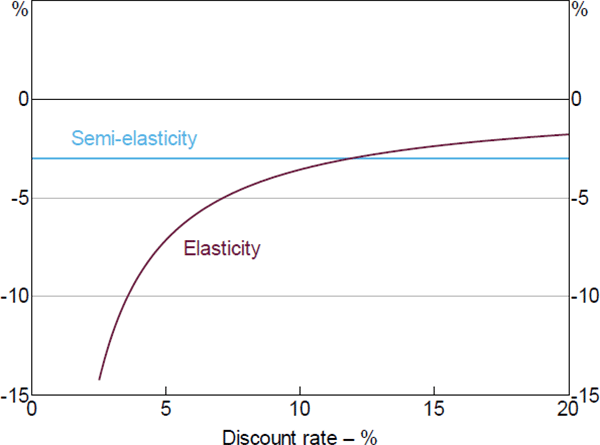RDP 2021-04: Monetary Policy, Equity Markets and the Information Effect Appendix C: Semi-elasticity versus Elasticity
April 2021
- Download the Paper 1,551KB
The baseline estimates for the ASX 200 index are estimated as semi-elasticities. Here, the response of the ASX 200 depends only on the absolute size of the monetary policy surprise and does not change based on the level of the interest rate. This approach is standard in the literature (e.g. Bernanke and Kuttner 2005; Bauer and Swanson 2019) and can also be derived from a Campbell and Shiller (1988) linear approximation of equity prices.
But there is a nonlinear relationship between the discount factor and equity prices (Equation (2)). That is, the effect of the same change in interest rates may have different effects depending on the initial level of the discount factor. This differential response becomes increasingly important the lower the initial level of the discount factor. To account for these dynamics, one would need to estimate an elasticity of the ASX 200 to the discount factor. I do this by dividing the scaled monetary policy surprises by the sum of the AGS 10-year nominal yield and an estimate of the equity risk premium prior to the monetary policy announcement.
Figure C1 compares the estimated effect of a 100 basis point monetary policy surprise at different levels of the discount rate. The semi-elasticity, used in the baseline results, is constant at 3.0 percentage points. While the effects when using the elasticity become larger as the discount factor decreases. When the discount factor is around 12 per cent the elasticity is roughly equivalent to the semi-elasticity. This is higher than the historical mean of the discount factor used, which is around 9.35 per cent. This suggests that in the current low interest rate environment the semi-elasticity could be underestimating the effects of monetary policy on the ASX 200 index.
Though using the elasticity may be more theoretically grounded, the estimation is not necessarily better than using a semi-elasticity. Using the elasticity requires one to first find the relevant discount factor, which includes determining a measure of the equity risk premia. This process is imprecise and adds uncertainty around the estimated parameters. Because of this I prefer the semi-elasticity results in the main text. Nonetheless, the elasticity results could be increasingly relevant in the current low interest rate environment.

Sources: Author's calculations; RBA; Refinitiv